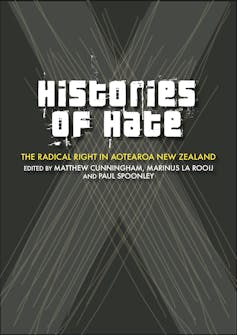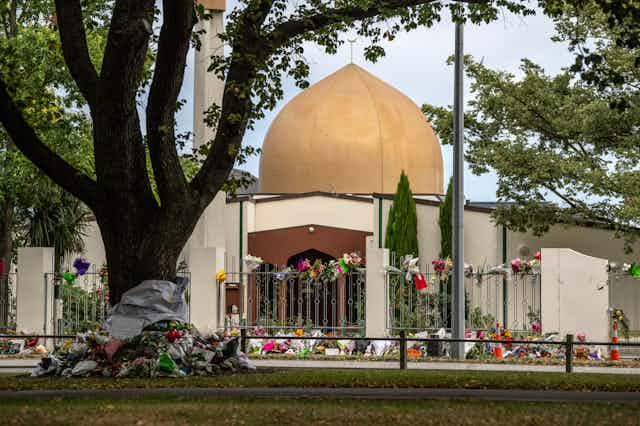The massacres of March 15 2019 at two Christchurch mosques confirmed the far right remains a constant threat to public order and safety in New Zealand, and that this threat was largely overlooked by security and intelligence agencies.
Both elements were corroborated by the findings of the Royal Commission of Inquiry into the attacks that was released in November 2020. The country was not exempt from such activist, murderous politics, despite widespread complacency.
While the perpetrator exhibited many of the longstanding ideological beliefs and violent tactics of white supremacists, his “manifesto” reflected the influence and rise of the alt-right, with a focus on the “great replacement”, the participation in online subcultures and new versions of conspiracies (as well as old ones).
We trace the development of the alt-right as a series of disparate coalitions of far-right and (white) ethnonationalist groups, activists and ideologies – secular and religious – and their use of online platforms to proselytise, recruit and radicalise. We are particularly interested in the rise of identitarian movements and ideologies, and their transnational influence and reach.
How has ethnonationalism been (re-)radicalised? How have new motifs and symbols been used to attract and explain, especially in identifying groups – the “deep state”, mass media, groups such as Muslims or Jews – as an existential threat facing the “white race” or “European civilisation”?
What role does religion play in these new coalitions and their selection of religious enemies and targets? How significant is the neglect of religion in the failure to recognise religious motivations and ideologies by security and intelligence agencies in secular polities? And how have online platforms and possibilities been utilised in the cause of these new politics?
A new stage in far-right politics
The alt-right is a product of the ideological mixing of traditional far-right politics and conservative populist movements. As David Neiwert writes in Alt-America: The Rise of the Radical Right in the Age of Trump, key elements began to appear with the Tea Party after 2010 in the US: nativist anti-immigrant views, specifically in relation to “ ‘parasitic’ minorities and immigrants”, a “hostility towards ‘liberal’ elites” and the “supposed ‘tyranny’ of the president”. Neiwert writes:
These populist movements have created an “[a]lternative universe [and] a set of alternative explanations [which are] amplified by a panoply of conspiracy theories [including] a New World order [which is] plotting to enslave all of mankind in a world government that permits no freedom […] In this alternative universe, facts and the laws of political gravity do not apply.

The term "alt-right” was first coined in 2009 by Richard Spencer, an American white nationalist disillusioned with contemporary conservatism and who became director of the National Policy Institute, a lobby group for race-based policies where “race is the foundation of identity” – a far-right response to, and version of, contemporary identity politics. A year later, Spencer established his own webzine, The Alternative Right.
By the 2016 US presidential election, the views and activities of the alt-right had become well established and provided a contrast to more traditional far-right politics – in two particular ways.
First, the alt-right were firmly internet-based. Secondly, many followed the Spencer tradition of the “suit-and-tie image” of white nationalism, the preppy look of middle America. The term gained traction when Hillary Clinton, as a presidential candidate, used it in a speech in August 2015 to critique white supremacy and her opponent, Donald Trump.
‘Networked white rage’
Explanations for the rise of the alt-right vary. Some, such as the author Jessie Daniels, see it as a “manifestation of the angry white male who has status anxiety about his declining social and economic power”.
There is certainly some evidence of a high degree of disillusionment and feelings of marginalisation in white communities in the US that then translates into support for an angry and exclusive nationalism through the second decade of the 21st century. Arlie Hochschild chronicles this in her compelling book, Strangers in Their Own Land.
The second explanation is that it is a product of the echo chambers of the internet – or “an informal and ill-defined collection of internet-based radicals”. Jessie Daniels goes on to argue:
The rise of the alt-right is both a continuation of a centuries-old dimension of racism in the US and part of an emerging media ecosystem powered by algorithms […] The ideology of the contemporary alt-right is entirely consistent with earlier manifestations of extremist white supremacy with only slight modifications in style and emphasis […] This iteration is newly enabled by algorithms [which] deliver search results for those who seek confirmation for racist notions and [which] connect newcomers to like-minded racists […] providing networked white rage.
The ideological positions of the alt-right are just as likely to be embedded in video games or music videos.

The red-pilled alt-right
A third component is the demographic profile of the alt-right. Many are young white males, some of whom are university graduates or students. Milo Yiannopoulos, a key US alt-right activist and commentator who, with Allum Bokhari, wrote “An establishment conservative’s guide to the alt-right”, described the movement as “born out of the youthful, subversive underground edges of the internet”.
In many ways, this is no different from earlier neo-fascist and neo-Nazi movements, such as skinheads, but the image and membership have changed: more intellectual (or claiming to be), more skilful messaging (by Canadian YouTube activists Stefan Molyneux and Lauren Southern, for example) and a more carefully managed appeal to conservatives, nationalists and populists.
The alt-right had been growing and evolving for some time, but the US presidential campaign in 2016 and the subsequent election of Donald Trump confirmed the presence and influence of the alt-right as a “mass movement” that hinged on the radicalising potential of the internet, especially of “disenfranchised and mostly anonymous, young white men”. As David Neiwert noted:
Alt-righters see [getting red-pilled] as a metaphor for what they consider to be the revelatory power of their ideology, which cuts through the lies of “social justice warriors” (SJWs), “cultural Marxists” and the mainstream media.
A new phase, and a variation on far-right political traditions and activism, had emerged by 2015–16. One element of this, which appeared alongside the alt-right, was identitarianism, which places the threat to the “white race” or “European civilisation” at the core of alt-right activism.
Identitarian politics
This term has been largely defined by Generation Identity, a European-based movement that arose from Bloc Identitaire, which was founded in 2002 in Nice. A youth wing was established a decade later, and was most apparent in Austria, Germany and Italy.
Generation Identity, one of whose leaders is Martin Sellner, an Austrian and former neo-Nazi, is a European analogue of the largely American alt-right. A core ideological concern is the “great replacement” and, specifically, as Julie Ebner wrote in Going Dark: The Secret Social Lives of Extremists, the belief that a mix of “pro-abortion and pro-LGBTQI+ laws had lowered birthrates of native Europeans, and pro-migration policies […] have allowed minorities to engage in a ‘strategic mass breeding’ .”
American identitarians formed Identity Evropa, which was renamed the American Identity Movement in the US in 2019. It has close links to Generation Identity in Europe and with the alt-right in the US.
Read more: White nationalism is a political ideology that mainstreams racist conspiracy theories
European identitarians have adopted some of the strategies of the alt-right, especially the Breitbart belief (a reference to Andrew Breitbart, an influencer of the alt-right and founder of the website that bears his name) that changing cultural narratives precedes political change.
In particular, there is the Breitbart argument that activists “need to create counter-cultures that attract young people [in order] to increase public pressure on mainstream politics”.
This is sometimes referred to as “strategic polarisation” or forcing bystanders to take a position either of support or against alt-right or identitarian ideological positions. The intent is to radicalise individuals or communities and to implement their own local or national campaigns.
Here is an example of seeking to alter the “Overton window” (changing the spectrum of politically acceptable views) and to move the political spectrum to the right so that alt-right and identitarian ideas become normalised.
Crisis narratives

Julie Ebner infiltrated Generation Identity groups in the United Kingdom and provided an excellent account (in her book Going Dark) of how such identitarian politics operate – and how such politics were a major influence on the March 15 terrorist.
Identitarianism is a movement that primarily advocates for a contemporary ethno-nationalism, is typically exclusive (hence, “re-migrating” non-natives and immigrants) and that portrays Islam as the key threat (therefore “de-Islamisation”).
This position was espoused by Renaud Camus in his book, Le Grand Remplacement (2011), which introduced the idea of “white genocide” and “reverse racism”, and has had a major influence on the ideological preoccupations of the alt-right. As Eibner writes:
The Great Replacement theory combines all four features of a violence inciting ideology [or] so-called “crises narratives”: conspiracy, dystopia, impurity and existential threat. The idea is that Europeans [sometimes labelled the “white race”] are being replaced with racially and culturally distinct migrants (impurity) by a cabal of global elites and complicit actors in governments, tech firms and media outlets (conspiracy), leading to the gradual decay of society (dystopia) and the eventual extinction of whites (existential threat).
Read more: Violent extremists are not lone wolves – dispelling this myth could help reduce violence
This theory, along with its four components, is found in a range of contemporary alt-right groups such as Action Zealandia. It was also a preoccupation of the March 15 terrorist whose manifesto, “The Great Replacement”, draws heavily on Renaud Camus’ You Will Not Replace Us! (2018), as well as the earlier work that also provided the rallying call to the Unite the Right rally in Charlottesville, Virginia, in 2017.
The terrorist also valorised Anders Behring Breivik and referenced the Norwegian’s manifesto alongside the justificatory confessions and statements of other terrorists, in particular highlighting the tradition of Christian crusader knights doing God’s work defending Christendom and Christianity against their enemies, mainly Muslims and Jews.
These precursors provided the symbols, memes, framework, inspiration and preemptive-strike strategy for the March 15 attacks.
This is an edited extract from Histories of Hate: The Radical Right in Aotearoa New Zealand, edited by Matthew Cunningham, Marinus La Rooij and Paul Spoonley (Otago University Press).

